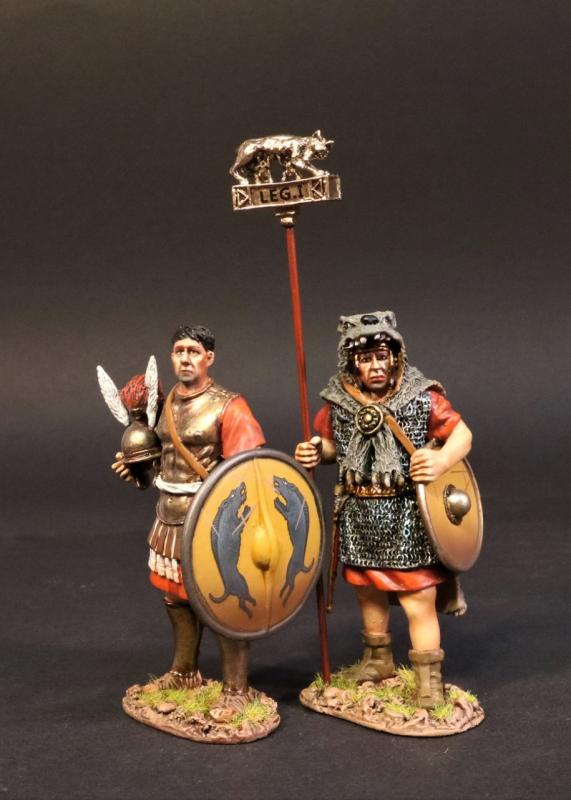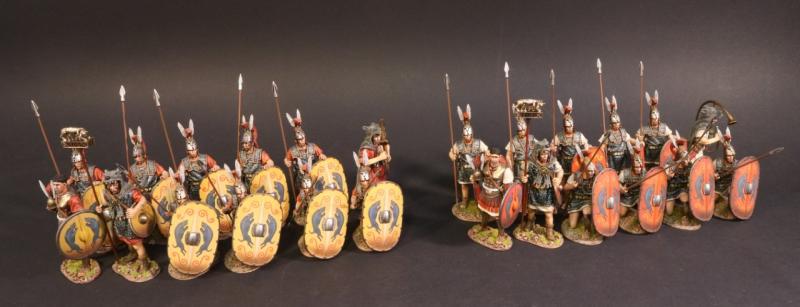Centurion and Signifer (yellow shields), the Roman Army of the Mid Republic, Armies and Enemies of Ancient Rome--two figures
$98.00
Item Number: TMRR-03BY
Centurion and Signifer (yellow shields), the Roman Army of the Mid Republic, Armies and Enemies of Ancient Rome
Republican Romans
The Roman Republic was the era of classical Roman civilization beginning with the overthrow of the Roman Kingdom, traditionally dated to 509 BCE, and ending in 27 BCE with the establishment of the Roman Empire. It was during this period that Rome's control expanded from the city's immediate surroundings to hegemony over the entire Mediterranean world.
Roman government was headed by two consuls, elected annually by the citizens and advised by a senate composed of appointed magistrates. As Roman society was very hierarchical by modern standards, the evolution of the Roman government was heavily influenced by the struggle between the patricians, Rome's land-holding aristocracy, who traced their ancestry to the founding of Rome, and the plebeians, the far more numerous citizen-commoners. Over time, the laws that gave patricians exclusive rights to Rome's highest offices were repealed or weakened, and leading plebeian families became full members of the aristocracy. The leaders of the Republic developed a strong tradition and morality requiring public service and patronage in peace and war, making military and political success inextricably linked. Many of Rome's legal and legislative structures (later codified into the Justinian Code, and again into the Napoleonic Code) can still be observed throughout Europe and much of the world in modern nation states and international organizations.
During the first two centuries of its existence, the Roman Republic expanded through a combination of conquest and alliance, from central Italy to the entire Italian peninsula. By the following century, it included North Africa, most of the Iberian Peninsula, and what is now southern France. Two centuries after that, towards the end of the 1st century BCE, it included the rest of modern France, Greece, and much of the eastern Mediterranean. By this time, internal tensions led to a series of civil wars, culminating with the assassination of Julius Caesar, which led to the transition from republic to empire.
Historians have variously proposed Julius Caesar's crossing of the Rubicon River in 49 BCE, Caesar's appointment as dictator for life in 44 BCE, and the defeat of Mark Antony and Cleopatra at the Battle of Actium in 31 BCE. However, most use the same date as did the ancient Romans themselves, the Roman Senate's grant of extraordinary powers to Octavian and his adopting the title Augustus in 27 BCE, as the defining event ending the Republic.
The Roman Army of the Mid Republic
For set-piece battles, the heavy infantry were usually drawn up in three lines.
However, the vast majority of the heavy infantry were stationed in the front two lines, the HASTATI and PRINCIPES. Contained in these two lines were the younger recruits who were expected to do all the fighting. The rear line (TRIARII), was a reserve consisting of older men who formed a line of last resort to provide cover for the front lines if they were put to flight (also to prevent unauthorized retreat by the front ranks).
The three lines of maniples were drawn up in a chessboard pattern (dubbed quincunx by modern historians, after the Latin for the "5" on a dice-cube, whose dots are so arranged). In front of these three lines of heavy infantry, would be stationed the legion's VELITES.
The Roman army of the mid-Republic (also known as the manipular Roman army or the "Polybian army"), refers to the armed forces deployed by the mid-Roman Republic, from the end of the Samnite Wars (290 BCE) to the end of the Social War (88 BCE). The first phase of this army, in its manipular structure (290–ca. 130 BCE), is described in detail in the Histories of the ancient Greek historian Polybius, writing before 146 BCE.
The central feature of the mid-Republican army was the manipular organisation of its battle-line. Instead of a single, large mass (the phalanx) as in the Greek and Early Roman army, the Romans now drew up in three lines (triplex acies) consisting of small units (maniples) of 120 men, arrayed in chessboard fashion, giving much greater tactical strength and flexibility.
The Republican army of this period, like its earlier forebear, did not maintain standing or professional military forces, but levied them, by compulsory conscription, as required for each campaigning season and disbanded thereafter (although formations could be kept in being over winter during major wars). Service in the legions was limited to property-owning Roman citizens, normally those known as iuniores (age 16-46).
The Centurions also appointed the bravest men as standard bearers, or Signifers. A signiferwas a standard bearer of the Roman legions. He carried a signum (standard) for a cohort or century. Each century had a signifer, so there were 59 in a legion. Within each cohort, the first century's signifer would be the senior one. The signum that he carried was the military emblem of that unit. It had a number of phalarae (disks or medallions) along with a number of other elements mounted on a pole. The pole could be topped with a leaf-shaped spear head or later a manus (open human hand) image denoting the oath of loyalty taken by the soldiers. It sometimes included a representation of a wreath, probably denoting an honour or award. The task of carrying the signum in battle was dangerous, as the soldier had to stand in the first rank and could carry only a smallbuckler. It was that banner that the men from each individual century would rally around. A soldier could also gain the position of discentes signiferorum, or standard bearer in training. If the signifer was lost in battle, the whole unit was dishonored. In addition to carrying the signum, the signifer also assumed responsibility for the financial administration of the unit and functioned as the legionaries' banker. He was paid twice the basic wage.
For the vast majority of the period of its existence, the Polybian levy was at war. This led to great strains on Roman and Italian manpower but forged a superb fighting machine. During the Second Punic War, fully two-thirds of Roman iuniores were under arms continuously. In the period after the defeat of Carthage in 201 BCE, the army was campaigning exclusively outside Italy, resulting in its men being away from their home plots of land for many years at a stretch. They were assuaged by the large amounts of booty that they shared after victories in the rich eastern theatre. But in Italy, the ever-increasing concentration of public lands in the hands of big landowners, and the consequent displacement of the soldiers' families, led to great unrest and demands for land redistribution. This was successfully achieved, but resulted in the disaffection of Rome's Italian allies, who, as non-citizens, were excluded from the redistribution. This led to the mass revolt of the socii and the Social War (91-88 BCE). The result was the grant of Roman citizenship to all Italians and the end of the Polybian army's dual structure: the alae were abolished and the socii recruited into the legions. The Roman army of the late Republic (88–30 BCE) resulted, a transitional phase to the Imperial Roman army (30 BCE –284 CE).
For set-piece battles, the heavy infantry were usually drawn up in three lines. However, the vast majority of the heavy infantry were stationed in the front two lines, the HASTATI and PRINCIPES. Contained in these two lines were the younger recruits who were expected to do all the fighting. The rear line (TRIARII), was a reserve consisting of older men who formed a line of last resort to provide cover for the front lines if they were put to flight (and also to prevent unauthorised retreat by the front ranks). The three lines of maniples were drawn up in a chessboard pattern (dubbed quincunx by modern historians, after the Latin for the "5" on a dice-cube, whose dots are so arranged). In front of these three lines of heavy infantry, would be stationed the legion's VELITES. The Roman army of the mid-Republic (also known as the manipular Roman army or the "Polybian army"), refers to the armed forces deployed by the mid-Roman Republic, from the end of the Samnite Wars (290 BCE) to the end of the Social War (88 BCE). The first phase of this army, in its manipular structure (290–ca. 130 BCE), is described in detail in the Histories of the ancient Greek historian Polybius, writing before 146 BCE. The central feature of the mid-Republican army was the manipular organisation of its battle-line. Instead of a single, large mass (the phalanx) as in the Greek and Early Roman army, the Romans now drew up in three lines (triplex acies) consisting of small units (maniples) of 120 men, arrayed in chessboard fashion, giving much greater tactical strength and flexibility. The Republican army of this period, like its earlier forebear, did not maintain standing or professional military forces, but levied them, by compulsory conscription, as required for each campaigning season and disbanded thereafter (although formations could be kept in being over winter during major wars). Service in the legions was limited to property-owning Roman citizens, normally those known as iuniores (age 16-46). For the vast majority of the period of its existence, the Polybian levy was at war. This led to great strains on Roman and Italian manpower, but forged a superb fighting machine. During the Second Punic War, fully two-thirds of Roman iuniores were under arms continuously. In the period after the defeat of Carthage in 201 BCE, the army was campaigning exclusively outside Italy, resulting in its men being away from their home plots of land for many years at a stretch. They were assuaged by the large amounts of booty that they shared after victories in the rich eastern theatre. But in Italy, the ever-increasing concentration of public lands in the hands of big landowners, and the consequent displacement of the soldiers' families, led to great unrest and demands for land redistribution. This was successfully achieved, but resulted in the disaffection of Rome's Italian allies, who as non-citizens were excluded from the redistribution. This led to the mass revolt of the socii and the Social War (91-88 BCE). The result was the grant of Roman citizenship to all Italians and the end of the Polybian army's dual structure: the alae were abolished and the socii recruited into the legions. The Roman army of the late Republic (88–30 BCE) resulted, a transitional phase to the Imperial Roman army (30 BCE – 284 CE).
Due to be released in AUGUST 2021.

